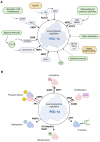PGC-1α Is a Master Regulator of Mitochondrial Lifecycle and ROS Stress Response
- PMID: 37237941
- PMCID: PMC10215733
- DOI: 10.3390/antiox12051075
PGC-1α Is a Master Regulator of Mitochondrial Lifecycle and ROS Stress Response
Abstract
Mitochondria play a major role in ROS production and defense during their life cycle. The transcriptional activator PGC-1α is a key player in the homeostasis of energy metabolism and is therefore closely linked to mitochondrial function. PGC-1α responds to environmental and intracellular conditions and is regulated by SIRT1/3, TFAM, and AMPK, which are also important regulators of mitochondrial biogenesis and function. In this review, we highlight the functions and regulatory mechanisms of PGC-1α within this framework, with a focus on its involvement in the mitochondrial lifecycle and ROS metabolism. As an example, we show the role of PGC-1α in ROS scavenging under inflammatory conditions. Interestingly, PGC-1α and the stress response factor NF-κB, which regulates the immune response, are reciprocally regulated. During inflammation, NF-κB reduces PGC-1α expression and activity. Low PGC-1α activity leads to the downregulation of antioxidant target genes resulting in oxidative stress. Additionally, low PGC-1α levels and concomitant oxidative stress promote NF-κB activity, which exacerbates the inflammatory response.
Keywords: PGC-1α; ROS defense; mitochondrial life cycle; mitonuclear communication.
Conflict of interest statement
The authors declare no conflict of interest.
Figures





References
-
- Lin J., Puigserver P., Donovan J., Tarr P., Spiegelman B.M. Peroxisome proliferator-activated receptor gamma coactivator 1beta (PGC-1beta), a novel PGC-1-related transcription coactivator associated with host cell factor. J. Biol. Chem. 2002;277:1645–1648. doi: 10.1074/jbc.C100631200. - DOI - PubMed
Publication types
LinkOut - more resources
Full Text Sources
Research Materials

